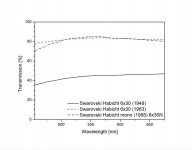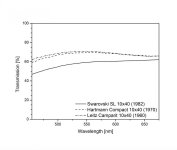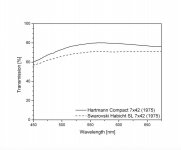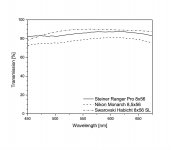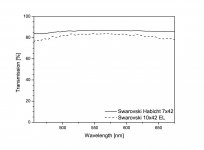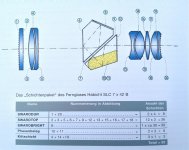I followed up on Gijs’ comment in post #11, regarding his PowerPoint presentation about Swarovski Optik
It provides some relevant transmission graphs, and I’ve attached 4
The original graphs - and a whole lot more - can be found in ‘History and quality development of Swarovski Optik 1935-present time’
The presentation comprises 100 slides, is 12 MB in size and is located at:
https://www.houseofoutdoor.com/verrekijkers/verrekijkers-testen-en-vergelijken/ (see about 2/3 of the way down the page)
1) Uncoated vs DV coated Traditional binoculars
A) 6x30 and 8x30N
Both models use the same objectives and prisms - only the focal lengths of the eyepieces differ, the 8x30N’s is shorter, with a wider Angular FOV and less eye relief
So in terms of glass and transmission, it’s a like-to-like comparison
The improvement in the low frequency DV transmission between 1958 and 1963, is notable
And a general level of 80% transmission, would not be too shabby for many multicoated binoculars up to the year 2000 or so
But the cost for the transmission performance, was the strong yellow colour cast to the image
[ EDIT: please read SWAROTOP for Swarobright below (Swarobright is the dielectric roof prism coating), see post #28. Thanks Henry, I got my Swaro-talk confused! ]
2) Swarobright coated SL binoculars
B) SL 10x40W (made from 1982 to 1992)
C) SL 7x42 (from 1980 to 1992)
D) SL 8x56B (from 1984 to 1998)
Optically, the SL uses the same glass as the Traditional design in a new housing e.g. the respective 7x42’s and 10x40’s each have the same AFOV and eye relief specifications,
but the close focus ranges differ in the SL due to mechanical constraints in the design
(despite appearances, the SL uses an external focus mechanism with the eyepiece assembly moving inside an outer housing)
The SL has the advantage of 2 less air-to-glass surfaces as the prisms are cemented
Gijs’ graphs show a wide range of performance, so I’ve sorted them into the order which presumedly reflects the progression in Swarotop coatings over time
Initial transmission values of the multicoated Swarobright SL’s were disappointing, when compared to those of the dual coated DV Traditionals:
- the SL 10x40’s performance is pathetic - basically just 10 to 15% better then the uncoated 6x30 Traditional!
- and the SL 7x42’s performance while better is not impressive - it tapers off at both ends of the spectrum, and is especially poor up to 520 nm
In contrast, what would be a later production SL 8x56, shows superiority to what was possible with DV coated optics:
- it has around 90% transmission for much of the range
- and significantly, this came with a much more neutral coloured image
The takeaway seems to be that it took Swarovski some time to combine better colour fidelity with improved transmission in it’s Swarobright coatings
Swarovski would have persisted, as it would have been obvious that 3 coatings would eventually provide performance well beyond that of 2
SOME CONCLUSIONS
Firstly, as all of the above are Porro prism designs, we’re avoiding the complications associated with the additional coatings needed on roof prism designs
And the Traditional and the SL models feature identical optics (with the SL having the minor advantage of 2 less air-to-glass surfaces)
So the points below are limited to:
- Traditional models (which did not have Swarobright coating until 1990/1991)
- and SL models, which were manufactured from 1980 to 1998 (and had Swarobright coating from 1982 at the latest)
By 1963, DV coating was capable of slightly over 80% transmission across most of the visible spectrum - though with the limitation of a strong yellow cast to the image
The yellow cast would be a deal breaker for some uses (e.g. birding) but inconsequential, or even beneficial, for other uses (e.g. hunting in low light/low contrast situations)
All things considered, the transmission performance was significant, compared to the single coated alternatives of the time
In the 1980’s, the first implementations of Swarobright multicoating may have provided a more neutral image but there were difficulties in achieving the transmission levels of the mature form of DV coating
By 1998 at the latest (with the end of the SL line), Swarobright exceeded DV capability, with around 90% transmission combined with a much improved (though not colour neutral) image
Prior to 2009, the use of Swarobright on Traditional models had been further significantly refined [see graph E), it is the 7x42 unit mentioned in posts #3 and #10]
While the transmission level was decreased to 86%, the transmission curve was extraordinarily flat
Clearly Swarovski chose to trade off a slight degree in maximum transmission to achieve a much more neutral coloured image (though still with a very slight tint)
And from 2009, Traditional binoculars have 94 to 96% transmission, again with a very flat curve, and the ‘paper white’ image now associated with them (e.g. see the link in post #10 above)
John
p.s. I'm getting more detailed information organised about the use of Swarotop on the Traditional line of binoculars. Ideally I'll post it tomorrow.






